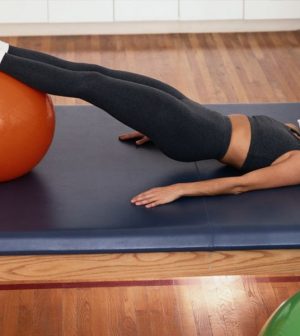- Navigating Your Midlife Crisis: Embracing New Possibilities
- City Raccoons Showing Signs of Domestication
- Mapping the Exposome: Science Broadens Focus to Environmental Disease Triggers
- One Week Less on Social Media Linked to Better Mental Health
- Your Brain Changes in Stages as You Age, Study Finds
- Some Suicide Victims Show No Typical Warning Signs, Study Finds
- ByHeart Formula Faces Lawsuits After Babies Sickened With Botulism
- Switch to Vegan Diet Could Cut Your Greenhouse Gas Emissions in Half
- Regular Bedtime Does Wonders for Blood Pressure
- Dining Alone Could Mean Worse Nutrition for Seniors
Creating a Home Gym on the Cheap

A state-of-the-art home gym might not just be beyond the scope of your budget, it also might be beyond the scope of available space. But don’t rule out this convenient fitness option so fast.
According to the American Council on Exercise, if you can clear a 6-foot by 6-foot area for working out, you can outfit a home gym with the basics for under $100. Plus, these space-conscious items can be stored in a closet or under the bed when not in use. Just don’t forget that they’re there once you buy them!
Start with a good mat for floor work, like yoga, Pilates, ab exercises and push-ups. The price typically depends on the thickness you choose, and thickness depends on what you’re using it for.
Next is at least one stability ball for doing a variety of exercises, including balance work and crunches. Choose one made for your weight and height. When you’re sitting on it, your thighs should be parallel with the floor.
Stretchy resistance bands are great for strength training when you don’t want a full set of weights. On their own, they weigh nothing and take up less space than a pair of socks. You might buy them in various tensions to match up with the different strengths of various muscle groups. There are also circular bands that go around your ankles for working the outer hips.
If you’d like to use dumbbells for upper body work, a set with three pairs of graduated weights is an inexpensive option. If you’re a beginner, choose a set with 3-, 5- and 10-pound weights; if you’re more experienced, go for 5-, 10- and 15-pounds.
However, you might get more mileage for your money with a barbell and weight plates — but again, start with low-weight plates and then add as you gain strength.
More information
For details on putting together an inexpensive home gym, check out the website of the American Council on Exercise.
Source: HealthDay
Copyright © 2025 HealthDay. All rights reserved.










